An active galactic nucleus (AGN) is a compact region at the center of a galaxy that emits a significant amount of energy across the electromagnetic spectrum, with characteristics indicating that this luminosity is not produced by the stars. Such excess, non-stellar emissions have been observed in the radio, microwave, infrared, optical, ultra-violet, X-ray and gamma ray wavebands. A galaxy hosting an AGN is called an active galaxy. The non-stellar radiation from an AGN is theorized to result from the accretion of matter by a supermassive black hole at the center of its host galaxy.

Seyfert galaxies are one of the two largest groups of active galaxies, along with quasar host galaxies. They have quasar-like nuclei with very high surface brightnesses whose spectra reveal strong, high-ionisation emission lines, but unlike quasars, their host galaxies are clearly detectable.
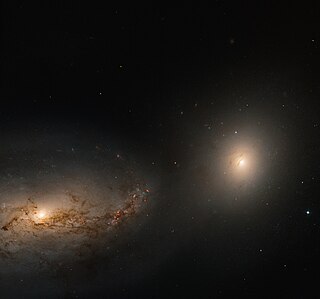
NGC 3227 is an intermediate spiral galaxy that is interacting with the dwarf elliptical galaxy NGC 3226. The two galaxies are one of several examples of a spiral with a dwarf elliptical companion that are listed in the Atlas of Peculiar Galaxies. Both galaxies may be found in the constellation Leo. It is a member of the NGC 3227 Group of galaxies, which is a member of the Leo II Groups, a series of galaxies and galaxy clusters strung out from the right edge of the Virgo Supercluster.

NGC 3226 is a dwarf elliptical galaxy that is interacting with the spiral galaxy NGC 3227. The two galaxies are one of several examples of a spiral with a dwarf elliptical companion that are listed in the Atlas of Peculiar Galaxies. Both galaxies may be found in the constellation Leo. It is a member of the NGC 3227 Group of galaxies, which is a member of the Leo II Groups, a series of galaxies and galaxy clusters strung out from the right edge of the Virgo Supercluster.

NGC 5005, also known as Caldwell 29, is an inclined spiral galaxy in the constellation Canes Venatici. The galaxy has a relatively bright nucleus and a bright disk that contains multiple dust lanes. The galaxy's high surface brightness makes it an object that is visible to amateur astronomers using large amateur telescopes.
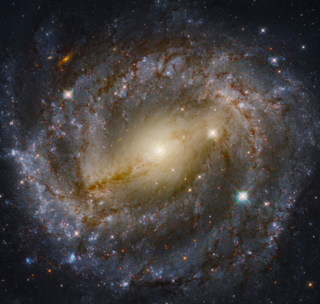
NGC 5643 is an intermediate spiral galaxy in the constellation Lupus. Based on the tip of the red-giant branch distance indicator, it is located at a distance of about 40 million light-years. NGC 5643 has an active galactic nucleus and is a type II Seyfert galaxy.
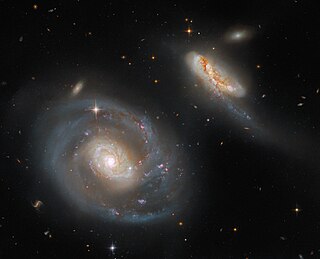
NGC 7469 is an intermediate spiral galaxy in the constellation of Pegasus. NGC 7469 is located about 200 million light-years away from Earth, which means, given its apparent dimensions, that NGC 7469 is approximately 90,000 light-years across. It was discovered by William Herschel on November 12, 1784.
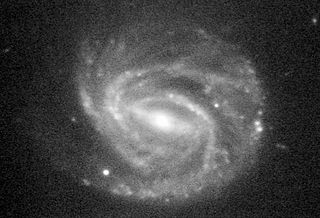
NGC 3367 is a barred spiral galaxy located in the constellation Leo. It is located at a distance of about 120 million light years from Earth, which, given its apparent dimensions, means that NGC 3367 is about 85,000 light years across. It was discovered by William Herschel on March 19, 1784.

NGC 7213 is a lenticular galaxy located in the constellation Grus. It is located at a distance of circa 70 million light-years from Earth, which, given its apparent dimensions, means that NGC 7213 is about 75,000 light-years across. It was discovered by John Herschel on September 30, 1834. It is an active galaxy with characteristics between a type I Seyfert galaxy and LINER.

NGC 7130 is a spiral galaxy located in the constellation Piscis Austrinus. It is located at a distance of about 220 million light years from Earth, which, given its apparent dimensions, means that NGC 7130 is about 100,000 light years across. It was discovered by John Herschel on September 25, 1834, and discovered independently by Lewis Swift on September 17, 1897. The location of the galaxy given in the New General Catalogue was off by 30 arcminutes in declination from the location of the galaxy.
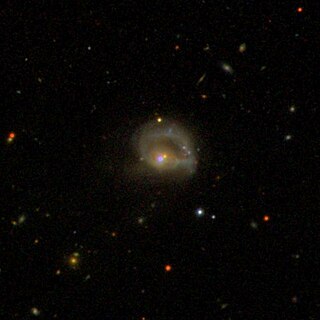
NGC 985 is a ring galaxy in the constellation of Cetus. It is located about 550 million light years away from Earth, which means, given its apparent dimensions, that NGC 985 is approximately 160,000 light years across. It was discovered by Francis Leavenworth in 1886. It is a type 1 Seyfert galaxy.

NGC 1386 is a spiral galaxy located in the constellation Eridanus. It is located at a distance of circa 53 million light years from Earth, which, given its apparent dimensions, means that NGC 1386 is about 50,000 light years across. It is a Seyfert galaxy, the only one in Fornax Cluster.

NGC 4278 is an elliptical galaxy located in the constellation Coma Berenices. It is located at a distance of circa 55 million light years from Earth, which, given its apparent dimensions, means that NGC 4278 is about 65,000 light years across. It was discovered by William Herschel on March 13, 1785. NGC 4278 is part of the Herschel 400 Catalogue and can be found about one and 3/4 of a degree northwest of Gamma Comae Berenices even with a small telescope.

NGC 5363 is a lenticular galaxy located in the constellation Virgo. It is located at a distance of circa 65 million light years from Earth, which, given its apparent dimensions, means that NGC 5363 is about 100,000 light years across. It was discovered by William Herschel on January 19, 1784. It is a member of the NGC 5364 Group of galaxies, itself one of the Virgo III Groups strung out to the east of the Virgo Supercluster of galaxies.

NGC 2273 is a barred spiral galaxy located in the constellation Lynx. It is located at a distance of circa 95 million light years from Earth, which, given its apparent dimensions, means that NGC 2273 is about 100,000 light years across. It was discovered by Nils Dunér on September 15, 1867.

NGC 3393 is a barred spiral galaxy located in the constellation Hydra. It is located at a distance of circa 180 million light-years from Earth, which, given its apparent dimensions, means that NGC 3393 is about 140,000 light-years across. It was discovered by John Herschel on March 24, 1835. It is a Type II Seyfert galaxy, known to host two supermassive black holes, which are the nearest known pair of supermassive black holes to Earth.
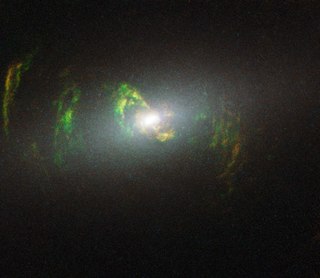
NGC 5252 is a lenticular galaxy located in the constellation Virgo. It is located at a distance of about 220 to 320 million light years from Earth, which, given its apparent dimensions, means that NGC 5252 is about 100,000 light years across. It was discovered by William Herschel on February 2, 1786.

Markarian 590, also known as NGC 863, NGC 866, and NGC 885, is a spiral galaxy located in the constellation Cetus. It is located at a distance of about 300 million light years from Earth, which, given its apparent dimensions, means that NGC 863 is about 110,000 light years across. It is a change looking Seyfert galaxy.

NGC 4253 is a barred spiral galaxy located in the constellation Coma Berenices. It is located at a distance of about 185 million light years from Earth, which, given its apparent dimensions, means that NGC 4253 is about 65,000 light years across. It was discovered by William Herschel on February 3, 1788. It is a Seyfert galaxy.
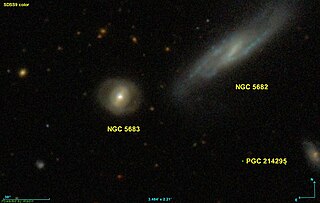
NGC 5683 is a type S0-a lenticular galaxy with a bar located in the Boötes constellation. It is 513 million light-years away from the Solar System and has an approximate diameter of 256,000 light-years meaning it is larger compared to the Milky Way. NGC 5683 was discovered by George Johnstone Stoney on April 13, 1850.


















